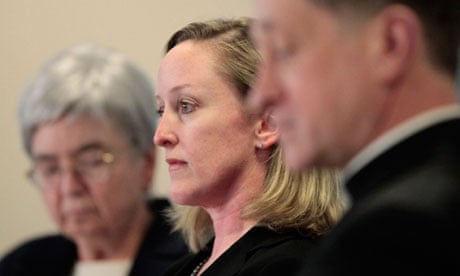A report on the child abuse scandal in the US Catholic Church has provoked condemnation for concluding that the permissive society of the 1960s was to blame for the rise in sexual offences by priests.
The investigation commissioned by Catholic bishops said that the peak incidence of sexual abuse by priests in the 1960s and 70s reflected the increased level of other deviant behaviours in American society in the period, including "drug use and crime, as well as social changes, such as an increase in premarital sex and divorce."
Researchers at John Jay College of Criminal Justice said most of the abusive priests were ordained in the 1940s and 50s and were not properly trained to confront the social upheavals of the 1960s.
David O'Brien, a historian of American Catholicism at the University of Dayton, said the report, Causes and Context of Sexual Abuse of Minors by Catholic Priests in the United States, 1950-2010, was dangerous because it seemed to exonerate bishops.
"This recalls an old tabloid banner headline from an early pre-Boston stage of this crisis: 'Bishops Blame Society'," said O'Brien, referring to the sexual abuse scandal in the Archdiocese of Boston in 2002.
The study said there was no single cause of the abuse and concluded that few of the abusive priests were paedophiles, as their victims were not all pre-pubescent.
Less than 5% of the abusive priests could be defined as paedophiles because the majority of victims were aged between 11 and 14.
"There's no indication in our data that priests are any more likely to abuse children than anyone else in society," said lead researcher Karen Terry.
But the finding was criticised by victims because the American Psychiatric Association defines paedophilia as an attraction to children aged 13 or younger.
The researchers added that their vow of celibacy did not make priests any more likely to become sex offenders. Nor was homosexuality to blame as the victims were of both genders.
The authors said the majority of abusive priests were "generalists" – sex offenders who do not specialise in a type of victim by age or gender or other characteristics.
Terry said this was exemplified by the case of the founder of the Legion of Christ religious order, the late Reverend Marcial Maciel, who sexually abused young seminarians and also fathered three children.
The Survivors Network of those Abused by Priests dismissed the report as "garbage in, garbage out" because the bishops providing much of the funding for the report.
But Terry defended the independence of the findings: "This is our report. None of the bishops had any influence on the findings of the study."
Researchers spoke with victims and their advocates, conducted surveys of bishops and diocesan officials who work with victims, and reviewed thousands of records, including a 1970s-era study on the psychology of priests and more than 1,000 case files of three treatment centres where abusive priests received counselling.
The researchers called the crisis "history" as they found abuse claims peaked in the 1970s then began declining sharply in 1985, as general awareness of child sexual abuse and its impact grew and bishops began to respond to reported cases.
But the study noted that church leaders remained more concerned with rehabilitating priests than with helping victims until 20 years later after those who suffered abuse mounted legal action.
